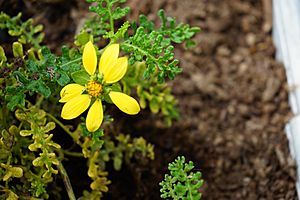Wing-fruited leocarpus facts for kids
Quick facts for kids Wing-fruited leocarpus |
|
|---|---|
 |
|
| Scientific classification | |
| Genus: |
Lecocarpus
|
| Species: |
pinnatifidus
|
| Synonyms | |
|
Lecocarpus foliosus Decne. |
|
Lecocarpus pinnatifidus, also known as the wing-fruited leocarpus, is a special kind of flowering plant. It belongs to the Asteraceae family, which is a large group of plants that includes daisies and sunflowers. This unique plant is found only in one place in the world: Floreana Island in the amazing Galápagos Islands.
Contents
What is the Wing-Fruited Leocarpus?
The wing-fruited leocarpus is a plant that gets its name from its interesting features. The word pinnatifidus in its scientific name means "deeply lobed" or "feather-cut," which likely describes its leaves. Its common name, "wing-fruited," tells us that its fruits might have wing-like structures. These "wings" can help the seeds spread, perhaps by catching the wind.
Where Does It Live?
This plant is a true native of the Galápagos Islands, a group of islands famous for their unique wildlife. Specifically, Lecocarpus pinnatifidus grows only on Floreana Island. This makes it an "endemic" species, meaning it naturally exists nowhere else on Earth. The Galápagos Islands are a volcanic archipelago in the Pacific Ocean, known for their incredible biodiversity.
What Does It Look Like?
While we don't have a full description here, we can imagine some of its features from its name. As a flowering plant, it produces flowers, which are likely important for its reproduction. Its leaves are probably deeply cut or lobed, giving them a distinctive shape. The "wing-fruited" part suggests its seeds are encased in fruits that have flat, wing-like extensions. These wings might help the seeds float on water or be carried by the wind to new places.
Why Is It Special?
Being endemic to just one island makes Lecocarpus pinnatifidus very special and also vulnerable. Plants that live in such small, specific areas are often at higher risk of disappearing. They can be threatened by changes to their habitat, new plants or animals brought to the island, or climate change. Protecting these unique species is very important for keeping the natural balance of the Galápagos ecosystem. Scientists and conservationists work hard to ensure plants like the wing-fruited leocarpus can continue to thrive.
How Does It Grow?
Like most flowering plants, the wing-fruited leocarpus goes through a life cycle that includes flowering, pollination, and producing seeds. Its flowers are likely pollinated by insects or possibly by the wind. Once pollinated, the plant develops its unique "winged" fruits. These fruits contain the seeds, which are the next generation of the plant. The wings on the fruit help the seeds travel away from the parent plant, giving them a better chance to grow in a new spot. This process ensures the plant can reproduce and continue its species on Floreana Island.

